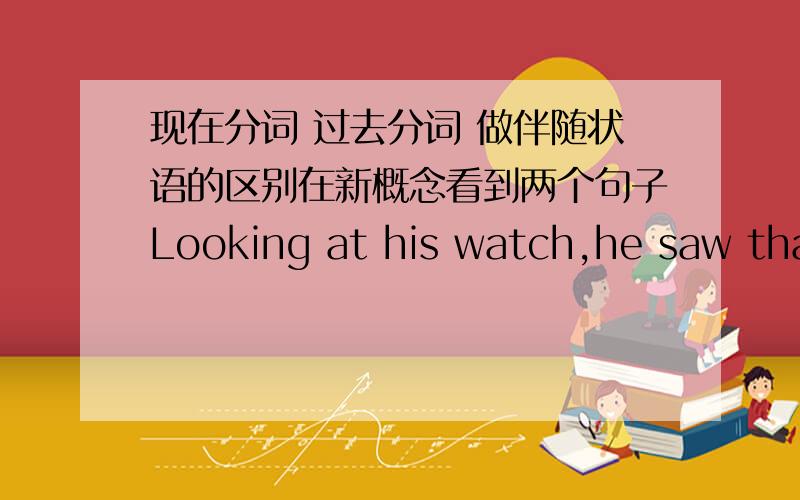现在分词 过去分词 做伴随状语的区别在新概念看到两个句子Looking at his watch,he saw that is was one o'clockArmed with a torch,the vicar went up into the clock tower to see what was going on.这两个句子,一个现在分词
来源:学生作业帮助网 编辑:作业帮 时间:2024/11/16 09:28:47

现在分词 过去分词 做伴随状语的区别在新概念看到两个句子Looking at his watch,he saw that is was one o'clockArmed with a torch,the vicar went up into the clock tower to see what was going on.这两个句子,一个现在分词
现在分词 过去分词 做伴随状语的区别
在新概念看到两个句子
Looking at his watch,he saw that is was one o'clock
Armed with a torch,the vicar went up into the clock tower to see what was going on.
这两个句子,一个现在分词做伴随状语,一个过去分词做伴随状语.
现在分词 过去分词 做伴随状语的区别在新概念看到两个句子Looking at his watch,he saw that is was one o'clockArmed with a torch,the vicar went up into the clock tower to see what was going on.这两个句子,一个现在分词
非谓语之分词篇
A.分词作定语
现在分词表“主动又正在进行着”
过去分词表“被动且已经完成了”
generally speaking ,vt.--->-ed作定语;vi---->-ing作定语
but,少数vi.也可用-ing 分词作定语表状态(eg.an retired worker / a broken window)
but,有些词既有vt.and vi.所以就有两种形式(-ed/-ing)作定语(eg.a developed/developing country)
* 如果分词是一个词的话,一般用前置定语.
分词改定语从句
The apartment (that was)bought last year is now worth more money.
定语(后置,从句……)其他形式,不在此具体讨论.
B.分词作状语(关键找逻辑主语)
a)放在句首的分词往往看作时间状语1以及原因状语2
1.Looking (when I looked) at the picture,I couldn't help missing my middle school days.
2.Seriously injured,Allen was rushed to the hospital.
=As he was seriously injured,Allen was rushed to the hospital.
b)放在句中或句末常常看作为伴随状态(并列句)
The girl was left alone in the room,weeping(crying )bitterly.
(但注意特殊:Generally/frankly speaking.../ taken as a whole(总的来讲)不考虑逻辑主语,看作为独立成分)
C.difference between "being done"&"done"
1)being done---->"又被动,又进行”
2)done------->“又被动,又完成”
1),2)均可作原因状语从句,而且更倾向于“done”,因为简单
eg.(being) deeply moved,she couldn't help crying.
但作条件(a),伴随状语只能用(b)2),不能用1)
eg.(a)Once seen,it can't be forgotten./If asked so many questions,Mary's face will turn red.
(b)she watched all the gifts ,greatly amazed.(=she watched all the gifts,and was greatly amazed在一般句中:v1,and v2/ v1,v2,and v3)
结论:当发现所要填非谓语为被动时,能用"done"就用"done"(除了有先后顺序(用(having done/having been done),详见D)
D.having done1)/having been done2)作状语时,分词的动作先于谓语动词
eg.1)Having handed in the paper,he left the room.(分词逻辑主语与主语相同,用having done)
2)Having been given a map,we found our way easily.(分词逻辑主语与主语不同,是别人给的,用having been done)
独立主格结构
有时分词可以带上自己的逻辑主语,由名词通格和代词主格表示,位于分词结构前,称为独立主格结构.可以表示时间、原因、条件或伴随状态.
例句:
the train coming in,they formed a line.(时间)
It being Sunday,there was no school.(原因)
Weather permitting,we will have the party in the garden.(条件)
He watched the scene,his mouth (being) wide open.(伴随情况)
有时独立主格结构可以由with引出.例如:
the child trembled,with hands red with cold.
The road is beantiful,with trees and flowers growing well here and there.
有时这种结构中的冠词或物主代词可以省去,称为泛指结构.反之,则称为特指结构.
umbrella in hand.
He came out,
with an umbrella in hishand.
guns on shoulders.
The guards stood at attention,
with guns on their shoulders.
语法书
独立主格结构由两部分,前一部分是名词或代词,后一部分是非谓语或其他词.前后两部分有逻辑主谓关系.独立主格结构在句中作状语,多用于书面语.分以下六种形式:
1.名词/代词+现在分词
mr Li being a senior teacher,we all respect him.
2.名词/代词+过去分词
Their work done,the workers left the factory.
3.名词/代词+不定式
They divided the work,the husband to do the shopping and the wife clean the rooms.
4.名词/代词+形容词
Ann came back from the country,her face black from the sun.
5.名词/代词+副词
The meeting over,the officials came out.
6.名词/代词+介词短语
The policeman was searching the house,gun in hand.
http://zhidao.baidu.com/question/133984782.html